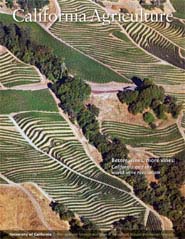All Issues

Better wines, more vines: California and the world wine revolution
Cover:
California's $45 billion wine industry continues to grow and change. In Sonoma County's Alexander Valley (shown), vineyards continue to expand, as do premium wine-growing areas along the coast. Photo: ©2008 Herb Lingl (aerialarchives.com)
January-March 2008
Volume 62, Number 1
Volume 62, Number 1





